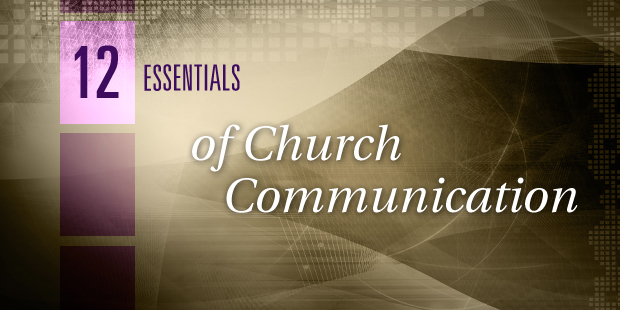
12 Essentials of Church Communications
The church is the hope of the world. As church leaders we have the responsibility of communicating the greatest message known to mankind; the only message capable of changing a person’s entire eternity.
The weight of that responsibility is both profound and incredible. It moves us to action, and demands that we communicate it well.
In the United States alone, we have 350,000 churches; each started by people with the desire to communicate the gospel message. Yet oftentimes, churches have a difficult time communicating this message because they don’t understand the basics of communication.
Think about it … Is your church clear on who they are and where they are going? Does your church use social media to nurture and grow relationships? Has your church spent unhurried time developing a brand that resonates with people in your church and community? Are you proud of your website and does it accurately communicate the uniqueness of your church? Have you evaluated and observed what guests experience on a Sunday morning? Do you want create more awareness of your church in local communities?
These things may not seem significant, but they are critical. In fact, they are essential.
We have researched and identified the 12 Essentials to Church Marketing and Communications and developed a resource that equips Church Communications leaders. And we did it for one reason; because eternity is at stake. We developed this important resource to help you reach more people with the gospel. We wanted to give you a sneak peek at the 12 Essentials.
The 12 Essentials to Church Marketing and Communications
#1 – Eternal Perspective
When it comes to Church Communications, it’s critical to remember that you want to produce an excellent product not for excellence sake, but because eternity is at stake. Lose that perspective, and you lose everything.
#2 – Vision Clarity
Vision clarity is about staying focused on the mission and vision of your church. To reach clarity, you must know who you are as a church and where you are going.
#3 – Brand Standards
Brand Standards are the compilation of documents where you articulate the mission, values, strategy, and vision of the church. They protect the treatment of everything from your logo and tagline, to fonts and color choice and even email signatures and phone messages. Brand Standards are critical but often overlooked.
#4 – Communication Strategy
Your communication strategy involves understanding your audience and then identifying the best way of communicating who you are to that audience. It helps you determine what, when and how you will communicate.
#5 – Project Systems
Andy Stanley says, “The systems down the hall trump the vision on the wall.” If you don’t have systems in place, standards and strategy mean absolutely nothing. The systems that you set in place allow the day-to-day operations to run smoothly.
#6 – Social Media
With over 845 million active users each day, Facebook reports an unbelievable 4 billion posts, likes, comments, and photo uploads every single day. Facebook and other social media sites understand the power of community. They understand that people want to be a part of something they feel connected to. Learning to use social media to reach the lost and to extend the influence of the church isn’t just a good idea, it’s a must.
#7 – Web Essentials
We live in a technology and social media driven society. Today’s church visitors will most certainly check out your church on the Internet before they attend for the first time. It must reflect the experience they will have when they do attend. It has to be more than just a website of information. It has to be an experience.
#8 – Guest Experience
There are few things first time guests expect when they visit your church. They expect to be greeted warmly; they expect to fill out a card with their contact information; and they expect someone from your church will follow up with them. Fail to meet any of these expectations, and they aren’t likely to return for a second visit.
#9 – Audience Connection
Ever been disconnected on the phone but not realize it until you have finished speaking? Then you understand the importance of making sure you are connected to your audience. To connect to your audience, you must understand who they are and how they take in information.
#10 – Creative Leadership
Creative people are not easy to lead and motivate. They are a breed of their own. Understanding how to lead creative people, and how to facilitate a creative meeting are critical. Moreover, learning to lead those in authority over you who lack creativity is equally important.
#11 – External Marketing
Churches and marketing have a rocky relationship. Historically, churches have not communicated effectively to their external audiences. Most churches make the same marketing mistakes: the message is not unique; the content is not inviting; and there’s no long-term strategy in place. If that description fits your church’s marketing, it’s time to make some changes.
#12 – Storytelling Principles
At the end of the day, stories move people. Effective storytelling is always more effective than just another event announcement. Vigorously find and celebrate the stories of people within and outside your church.
The 12 Essentials help you master the basics of Church Communications. Mastering the basics of church communications helps you reach more people with the most important message in the world.
Simply put, it’s essential.
Read more from Tim here.

Tags: Attention, Awareness, Tim Peters











